Bristol Road Sewer Pumping Station (2017)
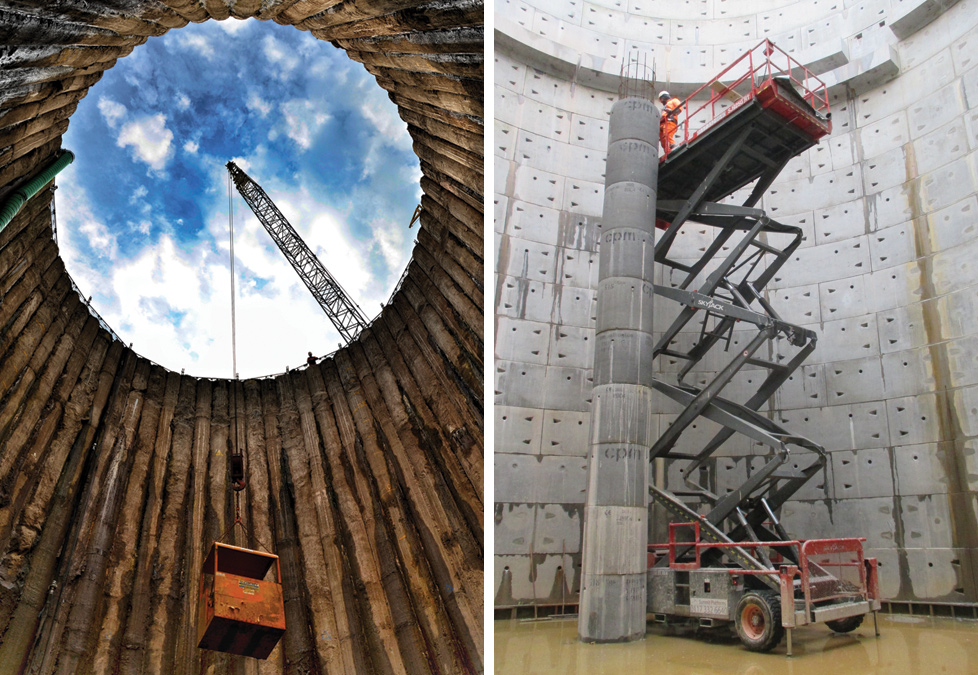
(left) Secant piles following excavation of shaft - Courtesy of Skanska and (right) Construction of support column - Courtesy of Lewis Civil Engineering Ltd
Burnham Jetty is the only ‘poor’ bathing water site in the Wessex Water region as categorised by the EU Revised Bathing Water Directive. Wessex Water has been working with the Environment Agency and committed £39 million to 12 schemes to improve this rating. Bristol Road Sewer Pumping Station (SPS) and Combined Sewer Overflow (CSO) rebuild is one of the major aspects of these works at £6.6m.
Driver
The overflow from Bristol Road SPS discharges directly to the River Parrett, which in turn flows into the Bristol Channel at Burnham-on-Sea. The hydraulic model predicted that the site spills approximately 21 times per bathing season, with a volume of combined flow equating to 20,254m3. To improve the bathing water it was agreed with the Environment Agency to reduce this number of spills. By increasing the pass forward flow to 165 l/s (from 100 l/s) and providing 3000m3 of storage, the frequency of spills was reduced to 1 per bathing season (1801m3).
The existing pumping station had legacy operational issues due to the very flat catchment in Bridgwater. With deep, flat sewers, the network discharged directly into the pump station at the invert level of the wet well. There was no operational volume within the SPS and hence the whole network was relied upon to fill before pumps operated.
Consequently, the pumps were operating three times a day, but running for a significant amount of time. Whenever it rained, a large amount of sediment and rags throughout the flat system would be flushed into the wet well, causing regular blockages and performance issues on the duty pumps.
There was no separate stormwater chamber; instead the storm pumps worked on a level sensor, within the same wet well, just above a gravity overflow to the surge tower. A coarse screen was located in a surge tower with a gravity outfall to the River Parrett.
The existing Bristol Road Site needed to remain live throughout any construction and operations need continuous access to the site. The upstream population is 4180, equating to a domestic dry weather flow of 7.5 l/s and a trade dry weather flow equating to 34.7 l/s. The timescale was just under three years from the start of concept design to operational site.
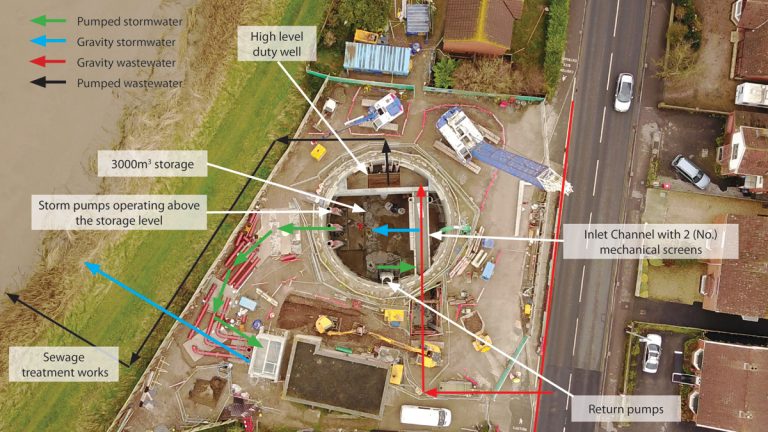
Bristol Road SPS during construction, with flow arrows – Courtesy of Wessex Water
Solution
It was necessary to design an integrated solution comprising a 15m diameter, 23m deep shaft pumping station, capable of storing 3000m3 of screened stormwater. By incorporating the storage requirement and pumping station, the team was able to utilise significantly more of the volume and save on building two structures, in a very restricted space. Additional monitoring has been incorporated in the design to ensure it is known when spills occur to the River Parrett and their duration.
Gravity flows enter the pumping station by a new connection on the existing line. The sewage flows through the inlet channel before dropping into the high level duty well. When storm flows beat the pass forward pumps of 165 l/s, the duty well and inlet channel levels rise and overflow through 2 (No.) Huber Technology Rok 2 mechanical screens and into the 3000m3 of storage. The storage space continues to fill.
If the storm subsides, flows will be returned back to the inlet channel. If the storm continues and the storage fills, this will lead to the storm pumps operating, lifting the storm flows into the newly extended surge tower and gravitating out to the River Parrett. The storm pumps have been sized to pump a 1 in 50 year storm event at high tide.
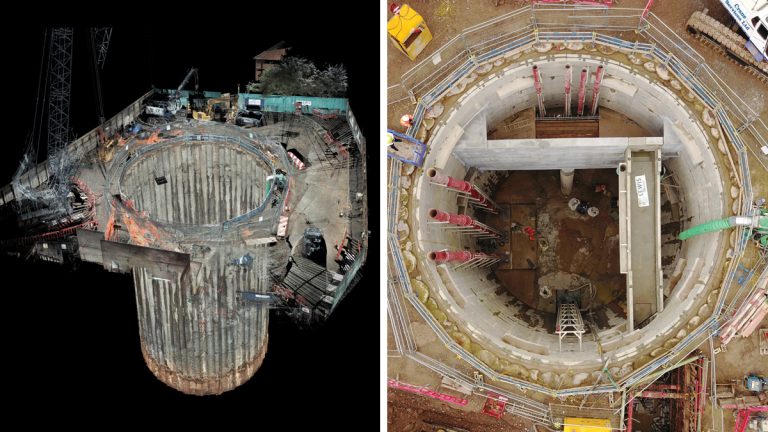
(left) Model of 3D survey of the excavated secant piled shaft – Courtesy Sedimentation Skanska and (right) Duty well with drop pipe curved de-aeration cowl and corner infill benching – Courtesy of Hydrotec and Wessex Water
Challenges
Challenges that had to be overcome included:
Location: Bristol Road SPS is located just off the busy A38, it is situated in between a tyre company and a residential building. Behind the site is a flood bank and footpath immediately adjacent to the River Parrett.
Ground Conditions: Boreholes suggested the upper regions of ground was made of alluvial clays and tidal flat deposits, followed by a narrow band of gravels (Burtle formation) until approximately 23m. Below 23m, Merica mudstone was prominent until at least a depth of 45m. The alluvium clay had a significant water content with minimal strength.
Dewatering with usual caisson construction methods was not going to be acceptable, due to the risk of settlement. Skanska designed and built a secant piled outer shaft with 66 secant piles each approximately 1.2m diameter, 30m deep. Half of the piles incorporated rebar, which allowed the piles to interlock, creating a watertight structure. This secant piled shaft was the largest in the UK without the need for ringbeams. Once the secant piles were complete, the whole shaft was excavated, enabling a bottom up segmental shaft and base plug to be installed.
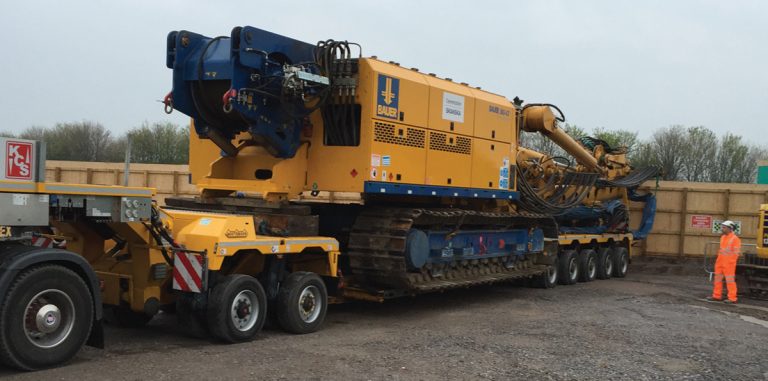
Drilling rig with scalloped guide – Courtesy of Wessex Water
Power: A new power supply was required. The storm pumps have been sized to protect against a 50 year storm, allowing for an astronomical high tide. Using a new power supply has allowed the whole site to be built and commissioned off line, before turning any of the flows from the existing pump station.
Wessex Water felt a backup generator was still required due to there being no gravity outfall for the storm overflow. If a gravity overflow pipe was installed it was believed that the risk of a flap valve (situated in a difficult location to maintain) failing and allowing river water into the storage shaft), was higher than that of the power failing.
Wet well design: The wet well design is a unique shape, as it is a curved backwall and sides. Wessex Water initially considered CFD modelling to test the structure, but instead chose for Hydrotec to test the wet well with a physical model. This allowed the incorporation of a number of simple innovations, which made a significant impact on the efficiency of the pumps.
These included vanes below the pumps, which encouraged laminar flow to enter the pump, the inclusion of a cowl at the bottom of a drop pipe to defuse energy and direct flows and screenings, and a bespoke benching design to minimise any settlement of solids or screenings.
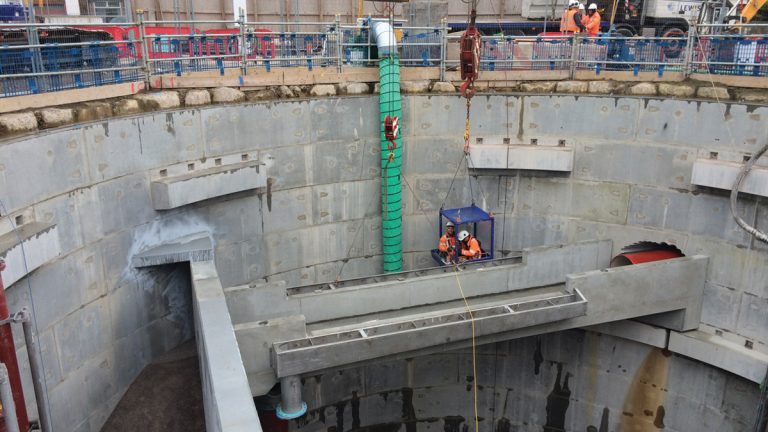
Construction of inlet channel and duty well – Courtesy of Wessex Water
Maintenance: It was a priority that Wessex Water operatives would not have to enter this site under any normal operation. It has been designed so that all equipment can be accessed from the surface. However, if absolutely necessary, access can be gained using a planned approach.
Wessex Water standards recommend slopes of 1:2 for benching in detention tanks, this would have meant a significant amount of mass concrete, that would not be needed for flotation. Several designs were looked at including flush mechanisms to clean the shaft. By working with Xylem Water Solutions (Flygt Pumps), Mouchel created a design that reduced the benching to 1:67 slope and would still provide cleansing, using a mixer pump.
The role of the mixer pump is purely to mix the bottom sediment 15 minutes prior to the return pumps returning the stored stormwater back into the inlet channel and ultimately pumped back to the treatment works. It is not designed to mix all the flows within the shaft or to create aeration etc.
Keeping the system live: Being able to construct the whole system off line was invaluable. A separate power supply allowed the commissioning to be carried out before final turning of the flows, Operations were able to witness the commissioning and see how the site will work, and gave greater confidence in the final successful operation of the site. The back-up generator will be permanently housed in the location of Bristol Road existing site allowing for the old pump station site to be demolished post a trial period of the new system.
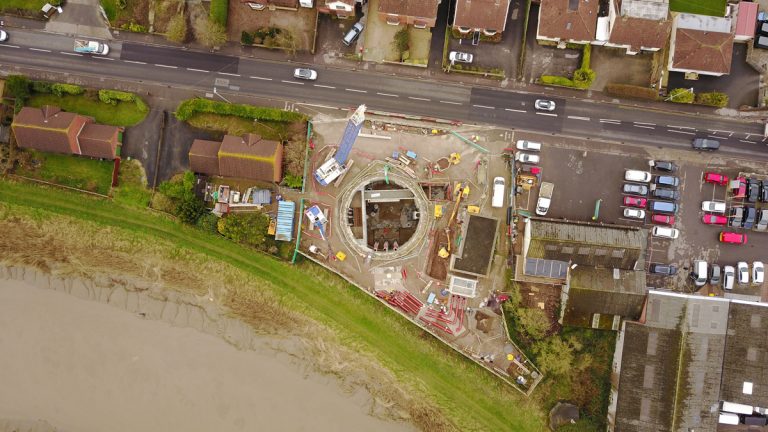
Bristol Rd SPS – whole site showing constraints – Courtesy of Wessex Water
Lessons learnt
The best accolade that was received came from operations recently, asking why a Bristol Road type solution had not been created on a different scheme that is likely to need updating in the next AMP. In a short period, the concerns for the innovative design have been allayed and the positive learnings spread to other areas. We challenged standards and in turn created new ones. Having restrictions in the project enables innovation.
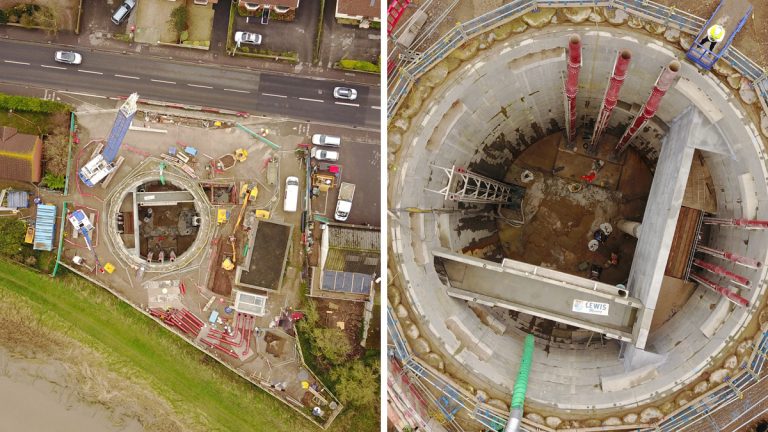
(left) Bristol Rd SPS – whole site and (right) Bristol Rd SPS shaft – Courtesy of Wessex Water
Summary
The hydraulic model anticipated that the site will now (on average) spill once per bathing season. The new integrated pumping station and storage structure was commissioned at the end of April 2017.
It can be seen from the telemetry and additional monitoring that has been installed that it is currently working well and has already been used in anger; storing flows that previously would have spilled into the River Parrett.
As wastewater assets begin to reach the end of their lives and usable space for new assets are at a premium the need to challenge standards and use joined up thinking is going to be paramount to providing buildable, cost effective solutions that are relevant and robust.









